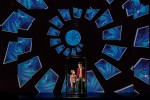People say not to talk with food in your mouth, but they never said anything about singing.
With gobstoppers in their cheeks, the cast members of “Charlie and the Chocolate Factory” set out to create a world of candy and color at the Hollywood Pantages Theatre. However, the show – which runs until April 14 – hit a few sour notes along the way.
The Roald Dahl story of an impoverished boy and recluse chocolatier has endured two big-screen adaptations: “Willy Wonka & the Chocolate Factory” (1971) and “Charlie and the Chocolate Factory” (2005). However, the 2013 musical stood apart from its film predecessors. The show essentially stayed true to the original story, but the Pantages rendition of the play had variable success in its execution of a confectionary paradise.
Contradictory to previous versions, the musical opened with Willy Wonka (Noah Weisberg) moonlighting as the shopkeeper of a candy store in the neighborhood of Charlie Bucket (Rueby Wood). Traditionally, Wonka was a mysterious figure introduced through the conversations of other characters. But in this rendition, his early introduction removed the intrigue that tends to characterize the figure.
However, the show made up for this loss through Charlie and Wonka’s humorous interactions, as the former worried over his chances of getting a golden ticket. For those who have seen both films, the musical’s interpretation of Wonka more closely resembles Gene Wilder’s quippy, irreverent misanthrope as opposed to Johnny Depp’s anxious and quirky take on the character. But in spite of his wisecracks and sassy hip swings, Weisberg missed the mark on dramatizing Wonka enough to ensure he stood out among the boisterous golden ticket winners he’s supposed to guide.
While certain changes to the story, like Wonka’s role as the shopkeeper, were debatable in their success, other twists in the production worked out much better. Factory guests Violet Beauregarde (Brynn Williams) and her father (David Samuel) – originally a white family – were instead portrayed as a black duo, adding refreshing and necessary diversity to the show’s cast. Comedic references to the “The Lion King” and Apple TV helped the production better relate to the audience and made the narrative feel more engaging in present times. Though these references weren’t compatible with the implied time period, their integration into the dialogue as quick asides prevented them from creating inconsistencies within the narrative.
Although most of the show utilized cheesy puns and witty quips that fit well within the confines of family-friendly humor, a few attempts at sexual innuendo fell flat. An illicit crotch grab and deliberate emphasis of the word “nuts” felt out of place in the story of an innocent boy’s adventure. Instead of adding a component of maturity to the show, the crude execution disrupted the rhythm of enjoyable, innocent humor.
Similar to the occasional script failures, the set design also wavered in its effort to create an imaginative wonderland. The show’s reliance on graphics and digital decor during the second act, which takes place inside Wonka’s factory, resulted in a one-dimensional – albeit colorful – display. Although there were candy canes and giraffes on stage, the candy forest scenery was primarily dependent upon a brightly colored graphic that resembled a children’s book illustration of the Amazon. Despite the elaborate projections, the sparse amount of props on stage resulted in a lack of texture and chaos one’s eyes hoped to see inside the wondrous workshop.
Much of the whimsy instead shone through the costumes. Each of the five children was dressed in trope-ridden, flamboyant costumes that emphasized their archetypes. Veruca Salt (Jessica Cohen), the temperamental ballerina, wore a white mink and audaciously pink tutu that flowed gracefully during her plie-filled tantrums. As the attention-loving queen of pop, Violet donned a rich, purple jumpsuit with brilliantly gleaming sparkles that no one could miss.
But, the costumes that shined the brightest were those of the Oompa Loompas. Their clever execution as half-costume, half-puppets made them comedic powerhouses in the second act. The infamous orange helpers were played by ensemble members wearing orange wigs and small, plush bodies draped from their necks. These inventive, yet silly costumes for the iconic characters bolstered the production’s playfulness.
The Los Angeles debut of “Charlie and the Chocolate Factory” brought along expectations of grand visuals, marvelous candy creations and fanciful language. Yet, the production’s venture into a realm of childlike imagination was bridled by certain efforts to refurbish the timeless tale – ultimately preventing the show from reaching its sweetest potential.
